Transportation
Unprecedented Disruption has Reshaped the Future of Logistics

Cushman & Wakefield releases 2021 Global Logistics Outlook
Cushman & Wakefield (NYSE: CWK), a leading global real estate services firm, has released its 2021 Global Logistics Outlook. The report analyzes key drivers affecting growth, global leasing dynamics and provides an outlook for the sector.
“The unprecedented disruption caused by COVID-19 pandemic and changing consumer behaviors has reshaped the future of the logistics industry by exposing global supply chain vulnerabilities and accelerating technological advances. As a result, a variety of global trends have emerged, propelling the sector forward in new ways,” said Cushman & Wakefield’s Jason Tolliver, Investor Lead, Logistics & Industrial Services, Americas.
North America
The North American industrial market experienced growth despite the COVID-19 pandemic wreaking havoc across the globe, as well as more local disruptions including hurricanes and wildfires. It has proven once again to be one of the most resilient asset types. Although North American new supply outpaced demand for the second year in a row, with 378 million square feet (msf) of completions, demand came in at 287 msf, surpassing 200 msf for the seventh consecutive year.
“COVID-19-induced lockdowns did cause a slight slowdown in demand in the first half of the year compared to prior years. However, even this combined with the large volume of supply has still not been enough to fully satiate tenant demand and to allow vacancy rates to begin to rise significantly,” said Tolliver. “Toward the end of 2020, North American industrial vacancy stood at 4.9%—just a 30 bps increase over 2019 and Canadian markets registered the lowest vacancy rates at 2.5% and Mexico City following at 3.0%.”
EMEA
“Europe’s logistics sector is grappling with supply constraints, stemming from a combination of a lack of developable land and strict planning regimes. In contrast to pre-Global Financial Crisis (GFC) when speculative development represented roughly 80% of new construction, post-GFC has been characterized by predominantly built-to-suit development that has led to severe supply shortages in most of Europe’s core logistics markets. As speculative construction resumed post-lockdowns more product came to market, pent up demand was released and leasing activity accelerated,” said Lisa Graham, Head of EMEA Industrial Research for Cushman & Wakefield.
Based on year-end data, vacancy continues to trend downward in most of Europe’s key logistics hubs. Vacancy of approximately 4% in Dutch and UK markets and vacancy hovering around 2% in Rotterdam, Lyon, Prague and Budapest, points to a severe lack of stock that, so far, a rise in speculative construction has been unable to alleviate. Furthermore, increased demand from e-retailers and 3PLs, as they expand their logistics footprint, has offset any vacancies created through tenant bankruptcies during 2020.
APAC
In broad terms, the regional industrial market remains resilient. Out of the 34 key markets covered within Asia Pacific, 15 are considered landlord-favorable with six being tenant favorable and the remaining 13 in neutral territory. The status quo has largely been maintained year-to-date, with only Singapore showing any significant change to becoming more tenant friendly, though this is restricted to certain parts of the industrial market. This is in stark contrast to the office sector within the region, which has seen a much more definitive shift towards more tenant-friendly conditions.
“Industrial rents have shown steady growth in the year-to-date in key Indian and South East Asian markets where rents in Delhi, Ho Chi Minh City, Kolkata, Jakarta and Hanoi have all increased by over 2.5%. Rents have been held broadly flat in Australia while they have seen a slight uptick of 2% in the Chinese logistics market, due to boosted demand from online shopping soaking up some of the vacancy,” said Dr. Dominic Brown, Global Head of Demographic Insights, APAC-lead for Cushman & Wakefield.
| Most Expensive | |||
| Rank | Country | Market | USD |
| SF/yr | |||
| 1 | UK | London | $ 24.90 |
| 2 | China | Hong Kong | $ 19.93 |
| 3 | U.S. | San Francisco Peninsula, CA | $ 18.25 |
| 4 | Switzerland | Geneva | $ 17.97 |
| 5 | Singapore | Singapore | $ 16.68 |
| 6 | Japan | Tokyo | $ 14.71 |
| 7 | Norway | Oslo | $ 14.68 |
| 8 | U.S. | San Francisco North Bay, CA | $ 14.62 |
| 9 | U.S. | Puget Sound – Eastside | $ 14.31 |
| 10 | Switzerland | Zurich | $ 13.97 |
| Least Expensive | |||
| Rank | Country | Market | USD |
| SF/yr | |||
| 1 | India | Hyderabad | $2.45 |
| 2 | India | Ahmedabad | $2.61 |
| 3 | Turkey | Izmir | $2.79 |
| 4 | Turkey | Ankara | $3.07 |
| 5 | India | NCR | $3.27 |
| 6 | India | Chennai | $3.41 |
| 7 | U.S. | Memphis, TN | $3.61 |
| 8 | India | Kolkata | $3.70 |
| 9 | Greece | Thessaloniki | $3.72 |
| 10 | U.S. | Columbus, OH | $3.95 |
“The global logistics sector not only showed resilience during the strict first half lockdowns but went on to benefit from consumer and business reactions to the pandemic during second half. Broadening e-commerce, both geographically and by product range, will be a key driver of new space demand over the next decade,” said Tolliver. “In a post-COVID-19 world, there will be greater focus on using real estate to leverage cost across the whole supply chain, better positioning businesses as they navigate a B2C business model, reshoring, inventory management, labor issues, transportation and ESG. Together, these factors will govern location strategy.”
Transportation
President Biden Joins Officials in Las Vegas to Announce $3B Grant for Nevada Department of Transportation for Brightline West
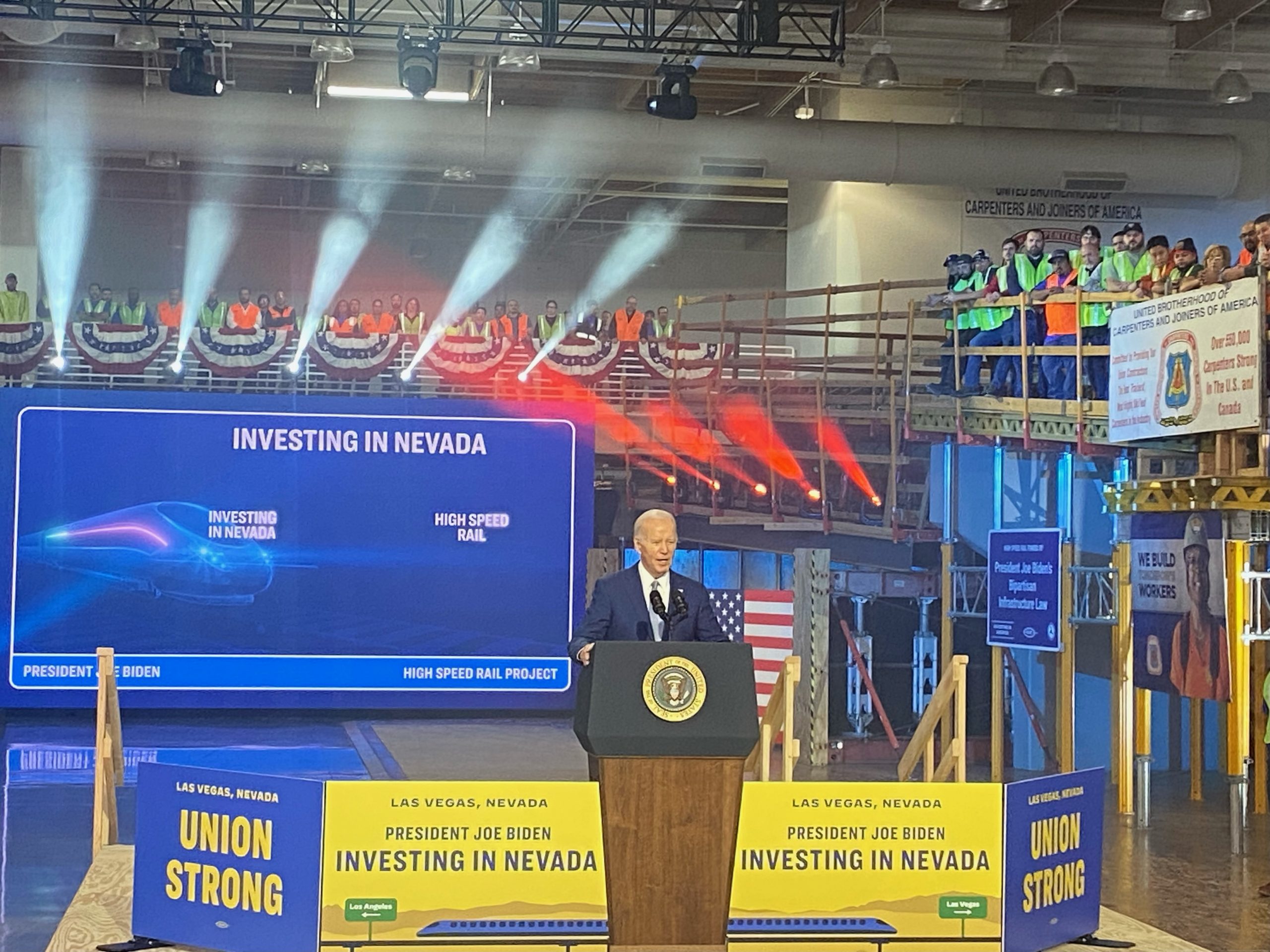
America’s First High-Speed Rail Project will Connect Las Vegas and Southern California
President Joe Biden joined elected officials from Nevada and California to formally announce that the Nevada Department of Transportation (NDOT) has received $3 billion in funding from the Federal-State Partnership for Intercity Passenger Rail Grant Program for Brightline West. Brightline West will connect Las Vegas and Southern California and will be the nation’s first true high-speed rail system. The project will also be the first to be built with American union labor. The fully-electric, zero-emission system will become one of the greenest forms of transportation in the U.S.
President Biden was joined by Nevada officials including Governor Joe Lombardo, Senators Jacky Rosen and Catherine Cortez Masto, Representatives Dina Titus, Susie Lee and Steven Horsford. Also in attendance were representatives from the High Speed Rail Labor Coalition and the Nevada Building Trades.
Brightline West’s modern, eco-friendly system will redefine train travel in America and connect two of the most iconic destinations: Las Vegas and Southern California. This 218-mile passenger rail service will reach speeds up to 200 mph with no grade crossings and the alignment is within the median of the I-15 highway. The system will feature three full-service stations in Las Vegas, Victor Valley and Rancho Cucamonga, Calif.
The Las Vegas station will include mobility connections and easy access to the Las Vegas Strip, the Raiders’ Allegiant Stadium and the Las Vegas Convention Center. The flagship Las Vegas station will be on 110 acres at the south end of Las Vegas Blvd. Brightline West’s California stations will include Victor Valley and Rancho Cucamonga, with direct connectivity via California Metrolink to key points in Los Angeles, such as Union Station.
Brightline West’s $12 billion project will bring widespread benefits including more than $10 billion in economic impact to Nevada and California. Economic studies show the project will create more than 35,000 (direct and indirect) jobs including 10,000 direct union construction jobs and nearly 1,000 permanent jobs for operations and maintenance. Brightline West’s investment also includes more than $800 million in roadway improvements to the I-15 corridor. Brightline West has agreements in place with several unions for the use of highly skilled union labor in critical jobs required to build, operate and maintain the project.
The project’s environmental benefits are equally impressive and designed to support Nevada and California’s climate strategies by promoting a no-emission mobility option that lowers greenhouse gasses by more than 400,000 tons of CO2 each year. The diversion of people from auto and air travel to Brightline West’s high-speed rail system reduces vehicle miles traveled by more than 700 million each year and 16,000 short haul flights annually.
The $3 billion grant award marks the largest in NDOT’s history and is the culmination of more than two decades of planning and coordination to build a high-speed rail line between Las Vegas and Southern California. NDOT, as the grant administrator, will continue to play an important oversight role as Brightline West constructs the rail system. Additionally, NDOT will be responsible for the design, construction, and oversight of any NDOT infrastructure that requires modification as a result of Brightline West’s work.
Transportation
Inland Empire Regional Chamber of Commerce Event to Spotlight Brightline West
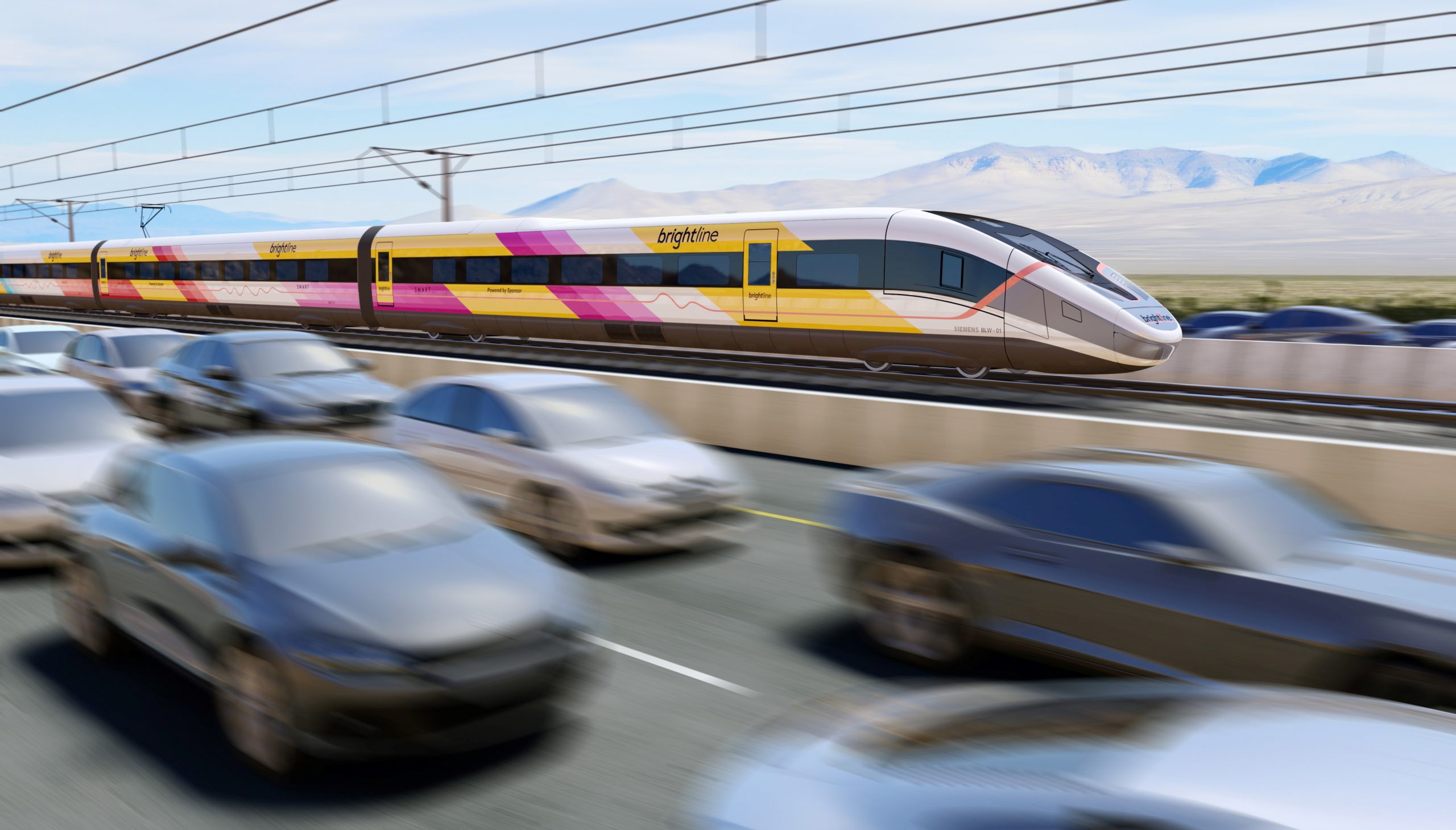
Program will highlight what’s next for high-speed rail in the Inland Empire
High-Impact Event Alert
Brightline West will be featured during the Inland Empire Regional Chamber of Commerce’s “High-Speed Rail is Headed to the Inland Empire” event on Wednesday, January 11, from 11:00 a.m. – 1:30 p.m. at Jessie Turner Community Center in Fontana, CA, which the County of San Bernardino is a title sponsor. The program will feature an update on Brightline West, including the project’s role in regional and statewide connectivity, its benefits to the community, what to expect in 2023, and how the public can stay engaged.
Featured panelists for the program are:
- Fiona Ma, Treasurer, State of California
- Ray Wolfe, Executive Director, San Bernardino County Transportation Authority
- Sarah Watterson, President, Brightline West
- Edward Ornelas, Jr., President/CEO, Inland Empire Regional Chamber of Commerce
- Matt Burris, Deputy City Manager of Community Development, City of Rancho Cucamonga
Brightline is the only private provider of modern, eco-friendly, intercity passenger rail service in America. The company currently serves Miami, Aventura, Fort Lauderdale, Boca Raton, and West Palm Beach in Florida, with its Orlando station beginning service in 2023. Recognized by Fast Company as one of the Most Innovative Companies in travel, Brightline offers a guest-first experience designed to reinvent train travel and take cars off the road by connecting city pairs and congested corridors that are too close to fly and too long to drive. Brightline West will build on this award-winning service by connecting Las Vegas and Southern California, with stations in Las Vegas, Victor Valley, Hesperia, and Rancho Cucamonga, and connectivity to Metrolink’s regional rail network.
“This will transform transportation in Southern California and Las Vegas for generations by providing a fast and efficient connection that gets people out of their cars, reduces traffic congestion and decreases air pollution.” -Fiona Ma, California State Treasurer
KEY FACTS:
- Expected travel time is approx. 2 ¼ hours
- Our route is 2x faster than driving
- Zero-emission, electric train sets
- Expected top speed is 180 mph
- 400,000 tons of CO2 removed annually by reducing 3 million vehicles
- Connections to Metrolink and planned future connection to California High-Speed Rail in Palmdale
- Convenient station location on the Vegas strip (I-15)
For more information and to register for the event, click here.
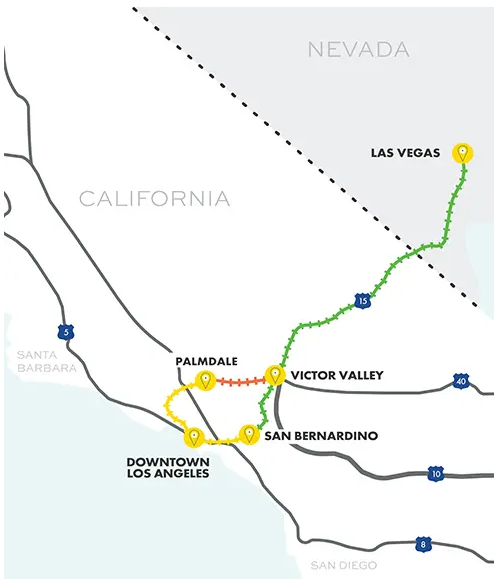
Transportation
Rancho Cucamonga and SBCTA Approve Sale of Property for Development of Brightline West Full-Service Transit Station

Agreement clears path for high-speed passenger rail service in the Inland Empire connecting Rancho Cucamonga, the High Desert and Las Vegas
The City of Rancho Cucamonga City Council and the San Bernardino County Transportation Authority (SBCTA) Board of Directors have approved the first step of the sale of a five-acre portion of the jointly owned property at Cucamonga Station to Brightline West. The agreement clears the path for Brightline West to develop the property at the northwest corner of Milliken Avenue and Azusa Court, and build the first high-speed rail station in the Inland Empire connecting Rancho Cucamonga, the High Desert, and Las Vegas. Brightline is the only private provider of modern, eco-friendly intercity rail service in America. The company currently operates between Miami, Fort Lauderdale, and West Palm Beach in Florida and is scheduled to complete construction to the Orlando International Airport by the end of 2022.
Cucamonga Station will go through a transformation in the coming years, making it the region’s global connectivity point and destination location for everything California has to offer. Transportation modes at Cucamonga Station will provide service through high-speed rail, the Metrolink San Bernardino Line, and Omnitrans Bus Rapid Transit and local bus service, as well as serve carpool commuters. Plans are also moving forward for a sub-terranean loop to Ontario International Airport (ONT), led by SBCTA, where passengers will be transported in just a few minutes between Cucamonga Station and airport terminals. In anticipation of deploying this service, Omnitrans has already launched ONT Connect, a regular shuttle service from Cucamonga Station to the airport that operates daily every 35-60 minutes.
“This agreement is a culmination of several years of working together with our partners and is a key milestone to bring high-speed rail to the Inland Empire,” said John Gillison, City Manager for the City of Rancho Cucamonga. “Cucamonga Station will serve as a global connectivity anchor within the newly branded HART District.”
“We are pleased to take this next important step forward in bringing enhanced transit connectivity to one of the fastest-growing population and economic centers in the country,” said Art Bishop, President of the SBCTA Board of Directors and Mayor Pro Tem of the Town of Apple Valley.
The Cucamonga Station will be strategically located within the HART District – a new transit-oriented, mixed‑use, housing, retail and commercial district that elevates the area into a walkable, culture-rich experience. Located within the area of Haven Avenue, Arrow Route, Rochester Avenue and the Transit station in Rancho Cucamonga, it will serve as a crossroads of food, travel, culture and commerce. The HART District is poised to be the next key economic catalyst in the region. To learn more, go to www.TheHartDistrict.com. The City of Rancho Cucamonga, Greater Ontario Convention & Visitors Bureau (GOCVB), Omnitrans, the Ontario International Airport, and San Bernardino County have established a joint effort for the project development and outreach programs. Additional project partners will come onboard as the project continues to move forward through the development process.
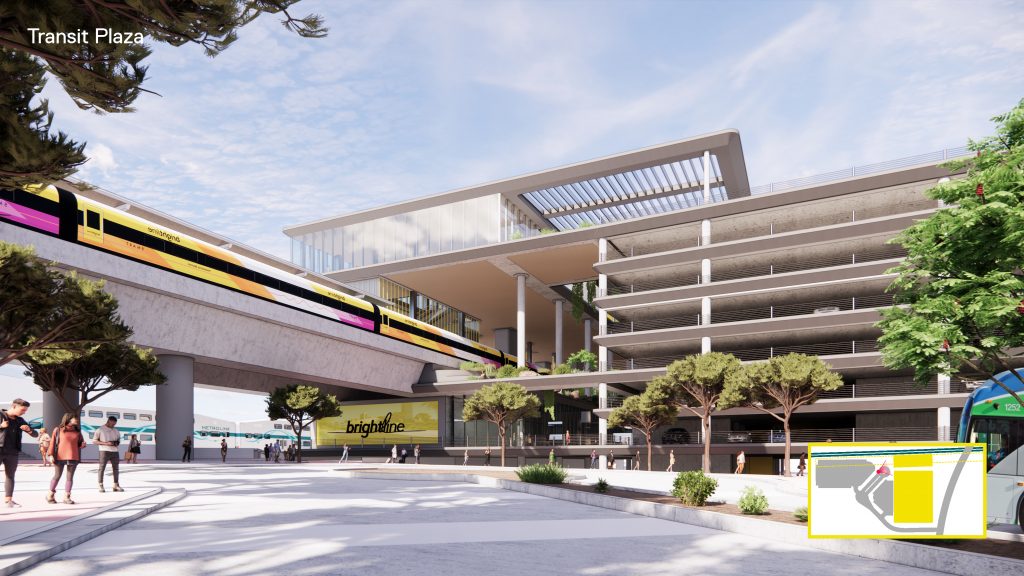
The Brightline West Cucamonga Station in Rancho Cucamonga, CA, will be home to the first high-speed passenger rail service in the Inland Empire connecting Rancho Cucamonga, the High Desert and Las Vegas.
Key Points to this Important Regional Project:
- Third-party analysis by Beacon Economics, a well-respected Inland Empire-based firm
- Construction is estimated to take three to four years, with ongoing operations beginning in 2026-27
- More than $300 million dollars in construction spending in Rancho Cucamonga and more than $5 billion dollars in construction spending in San Bernardino County during the next four years
- Estimated to support nearly 11,000 jobs per year across San Bernardino County and more than 700 jobs per year in Rancho Cucamonga during construction
- Rancho Cucamonga can expect to receive additional indirect spending in the local economy from the jobs generated particularly during the construction phase
- Much of the new jobs will be in the construction, architecture and engineering fields
- The City could receive an additional $1 million dollars per year in property tax/sales tax revenues during the construction (3-4 years)
- Ongoing operational revenues of another $500,000 per year for Rancho Cucamonga could be possible from local sales and property tax once the station is in full operation
- Project will stimulate housing demand throughout San Bernardino County during construction and add tens of thousands of jobs (direct and indirect) to the countywide employment base
- Countywide sales tax should increase near $100 million dollars and more than $70 million dollars from property tax during construction
- Long-term operational impacts countywide will be in excess of $6 million dollars from property/sales tax
-
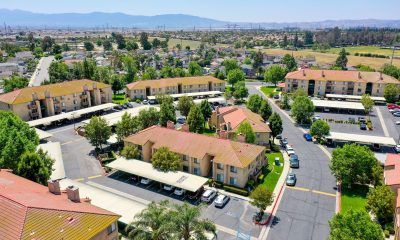
 By Press Release11 months ago
By Press Release11 months agoOntario Apartment Community Trades or $50.5 Million
-
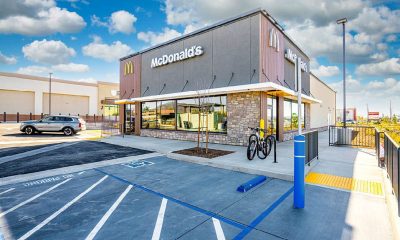
 By Press Release12 months ago
By Press Release12 months agoSRS Real Estate Partners’ National Net Lease Group Completes $3.3 Million Ground Lease Sale of a McDonald’s-Occupied Property Near Temecula, CA for a 3.48% Cap Rate
-
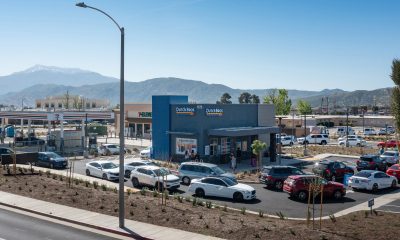
 By Press Release12 months ago
By Press Release12 months agoHanley Investment Group Arranges Pre-Sale of New Dutch Bros Coffee Drive-Thru in Riverside County, Calif., for $1.9 Million
-
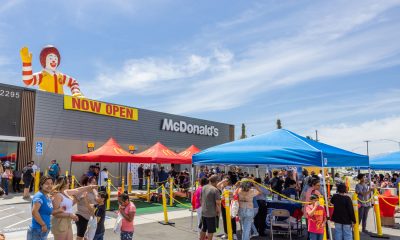
 By Press Release11 months ago
By Press Release11 months agoNew McDonald’s Restaurant Opening In Indio CA!
-

 Business12 months ago
Business12 months agoBeacon Economics Sets the Record Straight on the UCR Business Center Controversy
-

 Bizz Buzz8 months ago
Bizz Buzz8 months agoHernandez resigns as County CEO; Snoke will continue filling in pending Board action
















